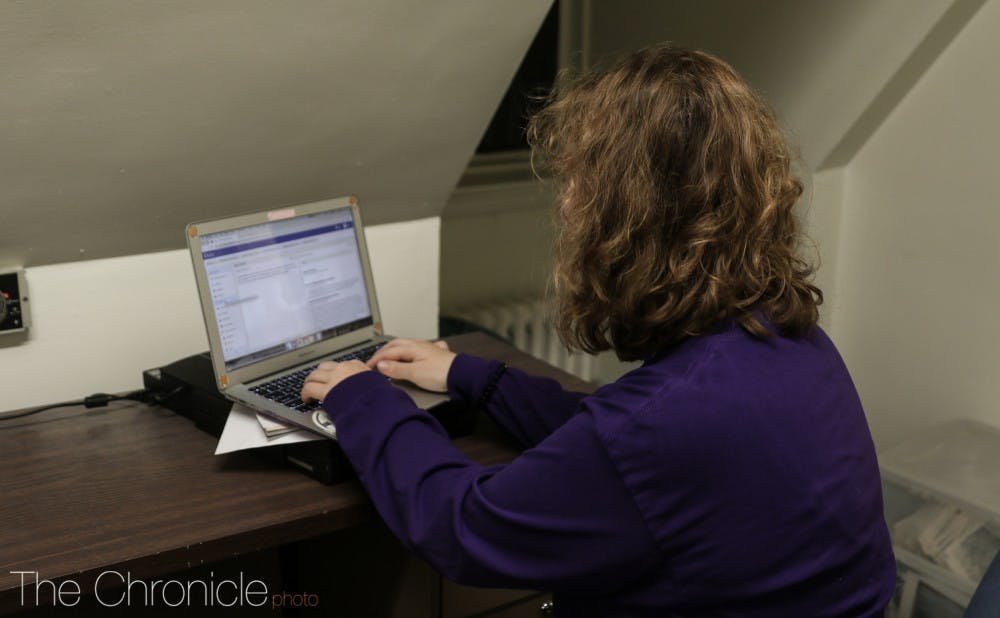When the WiFi goes out suddenly, students often rush to check Twitter or post about it on Facebook. Duke's Office of Information Technology is used to it.
One place where Duke students have noticed spotty coverage is outdoor areas.
“There are so many wonderful swingy benches and couches around the Edens dorms and in front of Bella Union, but the WiFi is spotty at best for most of them,” sophomore Bailey Bogle wrote in a message. “The same goes for the Gardens…it’s sad to be forced inside when the weather is gorgeous.”
Regarding connection coverage in outdoor spaces, Richard Biever, chief information security officer and director of identity management, explained that demand determines the priority for which outdoor areas get addressed.
“Outdoor spaces have less consistent coverage, and we prioritize those areas based on higher density of routine outdoor traffic,” Biever wrote in an email. “We currently have outdoor access at Bryan Center plaza, bus stops and outside some resident halls for food pickup. We are continuing to assess other outdoor areas for expansion as needed.”
Complaints on the Facebook Fix My Campus group reflect the frustration students on Central Campus feel about their WiFi.
Sophomore Grace Jeffrey wrote on the page that according to a speed test she ran, the download speed while using Dukeblue on Central Campus in general is around two megabits per second (mbps) compared to at least 50 mbps on the same server but in the Bryan Center. Jeffrey suggested installing signal boosters within Central Campus buildings, which she noted are in East Campus dorms.
Jeffrey also remarked in an interview to The Chronicle that the poor internet connection interferes with her daily activities and ability to perform tasks for her job.
“I try not to do my homework at home anymore because I know I can’t rely on the WiFi. I feel like I can’t do my work at home, and it’s really frustrating,” she said.
In Jeffrey’s case, Duke OIT readily responded to try to improve her situation after she posted on FixMyCampus. She explained that within a week of having posted online, OIT had filed and fulfilled a work order, installing an access point in her apartment to create more direct access to the campus server.
“At first it was awesome. I was running speed tests and before [the installment] download speed was about one mbps and afterward it was over 300 mbps,” she said. "But now, a month later, it’s at 30. That’s slow for WiFi generally, and if I’m FaceTiming someone or using internet to make a call—which is something I do for my job a lot—the connection will drop unexpectedly.”
Biever explained that OIT addresses every reported connection.
“When we receive a report that interior building spaces may not have ideal coverage, we do assess each situation and provide solutions such as tuning wireless signal strength or supplement with additional access points as needed,” Biever wrote.
Biever noted that many wireless cases are solved within one business day of their report. However, although posting on Facebook may be sufficient in some cases, it often isn't enough.
"Posting on social sites often does not provide enough information for OIT to resolve issues, which can delay how quickly we can fix a problem, and [OIT] encourages students to report Dukeblue issues to the OIT service desk as they occur," he wrote.
The office's Twitter account—@DukeOIT—posts continuous updates on every service issue and outage encountered on campus, from the first report of potential unavailability to final resolution.
Regarding general efforts to improve the WiFi on campus, Biever wrote that OIT regularly refreshes portions of the network to improve performance and coverage. Recent improvements include installing more than 4,000 access points across West and East Campuses in each dorm room and adding wireless coverage to Wallace Wade stadium in the summer of 2017.
This past summer, OIT refreshed wireless network coverage in Hudson Hall, Gross Hall, Social Sciences and Social Psychology—upgrading wireless coverage in large classrooms to accommodate increased demand—and tuning wireless signal in resident halls and library buildings.
“Our refresh efforts will continue throughout 2019,” Biever wrote. “We recently completed a core network upgrade and are working on a data center upgrade.”
Nevertheless, Jeffrey noted that in addition to Central Campus Wifi issues, connection in the Gothic Reading Room in the David M. Rubenstein Rare Book and Manuscript Library is “horrible.”
Additional efforts by OIT include monitoring and assessing the wireless network through monitoring devices in key locations that report back issues like disconnects, speed and reachability. They're also working with Cisco to implement a test lab for wireless configurations, code upgrades and introduction of new devices on the wireless network.
Get The Chronicle straight to your inbox
Signup for our weekly newsletter. Cancel at any time.

